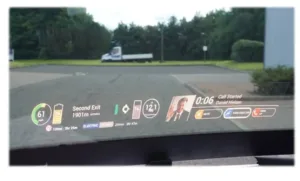At the recent SID Vehicle Display and Interface Conference, Ford Motor Company gave a presentation that described how they are testing a holographic film laminated into a windshield for use as a Head-up Display (HUD). The holographic film, called HoloFlekt®, is manufactured by Ceres Holographics, with the windshield lamination done in cooperation with Eastman and Carlex.
In the presentation, Ford described how they are testing the HUD performance along with necessary automotive safety related impact testing and durability requirements. This work is now complete so detailed discussions on integrating the HUD into vehicles can now begin.

HoloFlekt technology can transform any windscreen or other glass structure into an ultra-bright, full color display. (Source: Insight Media)
To learn more about the holographic film we spoke with Andy Travers, CEO of Ceres Holographic.
Holographic films that contain Holographic Optical Elements (HOE) are an emerging class of optical device that can be used to bend, shape, or direct light. Simple HOE structures like gratings are used in waveguides to capture, direct and expand images for Augmented Reality (AR) devices. When integrated into the windshield of an automobile, and illuminated by an LED projector they create the images the driver sees on a transparent background without having to wear any additional head gear.
For the automotive HUD application, Ceres’s holographic film acts like a projection screen for an LED projector. While this may sound like a simple optical function (diffusion) to record, it is way more complicated. For example, the light from the LED projector arrives at the holographic film at different angles and distances from the projector. This projected light must be redirected into a fairly narrow driver eyebox with good uniformity and color fidelity. It must also maintain high resolution, be bright, but also highly transparent to external light.

One way to create a hologram is to record the light from a physical object in a holographic film. This method, sometimes called analog, requires an object laser to illuminate the object along with a reference laser, both derived from the same laser. The laser light reflected from the object has its phase changed by the contours of that object, and when it interferes with the simple reference beam, creates a series of fringes. These fringes are then recorded in the volume of a photo-sensitive polymer film (photopolymer), and create the hologram. When this hologram is subsequently illuminated with the same angled simple reference laser (or LED) beam, the fringes alter the phase of the light and recreate an image of the object in true three dimensions.
Analog hologram recording methods don’t work well for creating the hologram for this application as there is no physical (diffuser) device that can create this functionality accurately. To solve this problem, Ceres has developed what they call pixel-wise HOE mastering. Here, the idea is to create a large holographic projection film via a series of smaller holograms. These so-called pixel-wise holograms are only 250×250 microns with each pixel-wise hologram calculated for its position in the overall holographic film. A step and repeat process is then implemented to complete the full-size film.
Each pixel-size hologram is a series of fringes or interference patterns recorded in the photopolymer film. Fringes for red, green, and blue LED light are calculated and blended together as an RGB fringe pattern. This pattern is then written to 3 separate spatial light modulators, which are special type of Liquid Crystal on Silicon (LCOS) device, and each simultaneously illuminated with red, green, and blue laser light. Once combined they form the “object beam” wavefront that now interferes with the reference beam at the photopolymer in the 250×250 micron window. Ceres Holographic likes to call this holographic mastering process “software-controlled printing.”
Ceres has now established both a hologram mastering process and a roll-to-roll holographic replication capability which uses the masters generated from their Gen 2 mastering machines. In this way, it can produce large windshield-sized films for lamination into windshields.

Ceres has primarily been developing automotive HUDs that feature a simple compact LED projector and a diffuser holographic film which is embedded into the windshield. This solution allows the projected image to be visible to the driver at the windshield surface.
In the AR-HUD application, HOEs with lensing optical power can project an image out in front of the car at a virtual distance and with large field-of-view. Making holographic masters like this using the same digital printed approach can be done and is in Ceres roadmap to develop.
However, the use of lenses/mirrors holographic films in an automotive windshield remains challenging. The problem, which Travers says nobody has solved yet, is the creation of unwanted rainbows visible to the driver when sunlight or streetlamps are diffracted by the windshield lens-type HOE. While there might be some solutions to reduce the visible rainbows in the driver’s eyebox, like windshield coatings, these are expensive and not likely to be viewed favorably by the auto makers. Other approaches include putting the lensing HOE inside or on top of the HUD projector box.
While development on this continues, Ceres is really focused on making diffuser-based HOEs which don’t exhibit the rainbow problem but deliver a vibrant and very wide field-of-view transparent display HUD.

Chris Chinnock holds a BSEE from the University of Colorado and has previously worked for companies such as General Electric, Honeywell, MIT Lincoln Labs and Barnes Engineering. In 1998 he founded Insight Media, which published newsletters (including Display Daily) and market reports plus custom consulting on the emerging parts of the display industry. Insight Media also produced many display events such Projection Summit, Display Summit, QLED and Advanced Display Summit, Streaming Media for Field of Light Displays (SMFoLD), and more. Chinnock also helped found and lead two display-focused industry organizations: the 3D @ Home Consortium and the 8K Association. He currently provides custom writing and marketing services for clients with advanced display-based technology.

